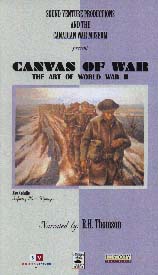|
________________
CM . . . .
Volume VII Number 17 . . . . April 27, 2001
Canada has a particularly rich tradition of wartime art, and the experience of producing art
under the conditions of war has been a major shaping influence on a large number of the
country's prominent artists. This hour video, produced by Sound Venture Productions, in
collaboration with the Canadian War Museum, does a very effective job both of introducing
that art (as it was developed during World War II), and of examining the experience of the
artists involved. Although the war is its subject and a continuous backdrop to the
commentary the video is not about war itself, but rather about the artist and the artistic
process in a time of national and social crisis, and in a setting of
moral horror and confusion.
Among the major contributions of the film is its very clear illustration of the value and
importance of art in explaining and interpreting events in a way that no other medium
including film can do. The case is made very effectively that the artist is an essential part of a
country's being able to come to understand itself, and of its citizens as individuals being able to
come to understand the human and emotional dimensions of the larger social events
surrounding them. (And it is interesting to note that a particularly strong and convincing
political voice in support of that critical role of art was Raymond Massey, then the Canadian
High Commissioner in London, and later the principal architect of the so-called Massey Royal
Commission that gave birth to the Canada Council and to a number of other initiatives in
support of the artistic enterprise. It is instructive to reflect how much of a nation's heritage can
depend ultimately on the efforts of a single protagonist.) As a reminder of the central place and
role of art in personal and community self-knowledge, the video has made a significant
contribution.
But beyond that issue of the role of art per se, the video is an instructive introduction to what
this role means for the artists themselves. Clearly, genuine art is not something that can be
prescribed or ordered; and what is produced (as opposed to what is exhibited, of course) is not
within bureaucratic control, even in wartime. An interesting aspect of the story involves just
that political dimension, where those in control of the war art program, and those participating
within it, often reflect quite different views of the point and purpose of the exercise: the
bureaucrats wanting heroic "poster art" or at least camera-like
"realism," and the artists
themselves searching out a way to express and respond to the experiences that confront them
on the battlefront and the home front. The fact that they were ultimately given comparatively
free artistic license speaks well of the leadership. Once the war had ended, and the need for
"instrumental art" had passed, the nation was left with a rich legacy of works of the first quality
and a body of art (exceeding 5000 pieces) that could continue to speak to subsequent
generations of the nature and human meaning of war.
The format employed for the video seems particularly appropriate for the subject and goals.
Film footage from the war is juxtaposed to the artistic renderings; and a number of the principal
artists are able to speak to their recollections, in juxtaposition to film footage of their
experiences in action. Among the rich range of artists portrayed are Alex Colville, Aba
Bayefsky, Bruno Bobak, Miller Brittain, and Lawren Harris each, in the way of artists,
reflecting a quite different experience. Fascinating as well is the story told primarily through
the stories of Pegi Nicol MacLeod and Molly Lamb Bobak of the special struggle for
involvement and recognition faced by female artists, and the important ultimate contribution
they made to the artistic representation of the home front the hospitals, the factories, and the
everyday lives of those constantly awaiting news from the battle front.
Although a comparatively brief production, the video makes a significant contribution, both to
our understanding of an important part of our cultural heritage, and to our understanding of the
place and role of art in our understanding of our own human experience. The video would be a
very useful addition to any history or social studies course or art course - at the senior high
level and beyond.
Highly Recommended.
Alexander D. Gregor is the Associate Dean (Graduate Programs), Faculty of Education, University of Manitoba
To comment on this title or this review, send mail to cm@umanitoba.ca.
Copyright © the Manitoba Library Association.
Reproduction for personal use is permitted only if this copyright notice
is maintained. Any other reproduction is prohibited without
permission.
Published by
TABLE OF CONTENTS FOR THIS ISSUE - April 27, 2001.
AUTHORS |
TITLES |
MEDIA REVIEWS |
PROFILES |
BACK ISSUES |
SEARCH |
ORDER |
CMARCHIVE |
HOME
|
